
| CSS\Adventurer Trucks | Sweptline Power Wagons | Medium/Heavy Duty Trucks |

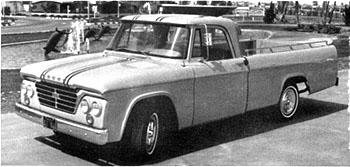
Part of our interest, then, in testing the Dodge D-lOO Sweptline lay in investigating this phenomenon, proving out our theory if possible and for awhile enjoying the position of big brother rooster among the automotive flock.
The Sweptline turned out to be magnificently suited to our purpose, a thing of power and purpose, loaded, incidentally, with enough optional equipment and accessories to make a kustom kar addict sit up and beg. To the outside viewer, the most apparent of these extras were: a pair of black racing stripes sweeping up and back over the hood and cab, a pair of gleaming chrome side rails along the upper edges of the box (which harmonized nicely, we thought, with the chrome side strips, chrome side mirrors, chrome wheel covers and the chrome bumpers all optional) and whitewall tires. The principle of conservatism was further bludgeoned by the truck's color-a coat of brilliant shamrock green. We wouldn't have been too surprised to find a calliope keyboard built into the instrument panel.
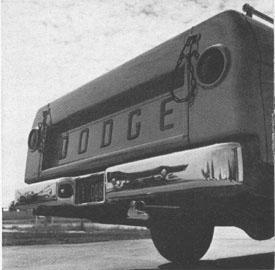
The bucket seats (from a Dodge Dart GT, installed to determine consumer acceptance) were completely comfortable, allowed a good driving position and, best of all, gave a degree of side support highly reassuring to those of us who have made that long cornering slide down a standard pickup bench seat. On the other band, a third passenger would have only three choices: straddle the between-seats console (another public-acceptance test item, this time plucked from a Polara 500), find a friendly lap or hunker down out back in the fresh air.
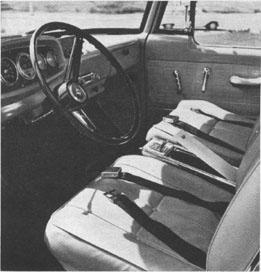
Our first familiarization run gave an indication of the ample power we were to enjoy every time we drove the D-100. Feeling rather effete about the very presence of a set of transmission pushbuttons inside the cab of a truck, we punched D, pushed down the accelerator pedal-and held on! First gear pressed us firmly back into the seat, 2nd came in with a brisk thump and a businesslike chirp from the rear tires, then feathered firmly out into 3rd.
With no further reservations regarding the truck's performance or the virility of the transmission, we went looking for traffic. Within a half-hour we had proved our theory regarding the pickup's easy dominance of traffic patterns (at least to our own satisfaction) and had become firmly attached to the Sweptline, chrome filigree and all.
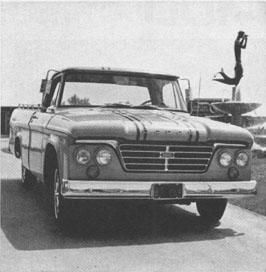
A matter of deep interest to manufacturers has been the emergence of the pickup truck from its former strictly utility category and its growing popularity as a pleasure vehicle, either as-is for rough country trips into unimproved hunting and fishing grounds, or with one of the various camper conversions locked into the pickup box and filled with supplies and relatives. The pickup definitely has begun to infringe upon the station wagon's multi-purpose province, or perhaps it would be more accurate to say that the station wagon has begun to abdicate its former position. Except for an occasional nonconformist like the Studebaker Wagonaire, station wagon design has become more and more ingrown, bland and similar as designers have sighted in on the suburbanite's ever-increasing demand for luxury and ever-diminishing demand for versatility. The pickups, conversely, become more versatile every year and, as our test car showed, can be given an almost boudoir like luxury. According to Jack McFarland, Manager of Dodge's Western News Bureau, pickup trucks currently account for 87% of all truck sales in Southern California, representing enough dollars to make a mound visible all the way from Detroit.
So far, our praise of the Sweptline has been pretty much undiluted. However, there are a few, admittedly minor, items which we would have changed. First, the instrument lighting was inadequate at night-a simple enough matter to correct, and thus all the less excusable. The instruments, including an optional tachometer and oil-pressure gauge, were honest, legible, black-and-white-dial, moving-needle affairs. One item that we'd like to see on ordinary passenger cars was the truck's "traffic hazard warning switch," which flashed the lights on all four corners of the truck-and all at the same time. We never found a legitimate excuse to use it while we had the truck, but can remember several anxious occasions in the past when we'd have given a great deal to have had it flashing fore and aft.
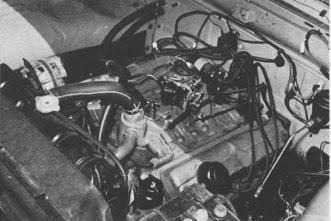
Opportunities to test the pickup under actual farm conditions were limited by a shortage of baled hay or shucked corn around the office. However, we did manage to accumulate about 800 lb. of miscellaneous junk and toured it around the countryside over the worst roads we could find. Performance felt as good as when the truck was empty and, in fact, putting a little weight on the optional 1400-lb. rear springs actually helped the ride. Those garish chrome side rails turned out to be ideal for lashing the load into position.
In summary, the Sweptline looked like a St. Patrick's Day parade all by itself, but was everything that a pickup truck should be, and more. Now they'll never keep it down on the farm. END
See the included chart image from this article by clicking here. The chart is quite comprehensive, and would actually apply to any `61-`65 D-100 Longbed (122" wb) with the Polysphere 318 installed. Figures such as gas mileage, pulling power, speedometer error, and much much more can be found on this chart.
Reference:
Unknown Author. "Dodge D-100 Sweptline Pickup." Car Life August 1963:
12-14